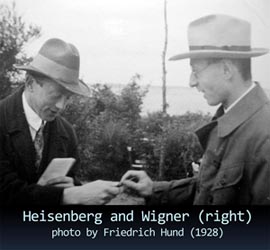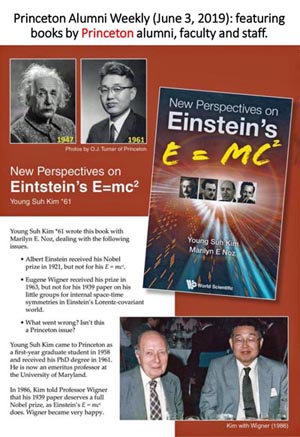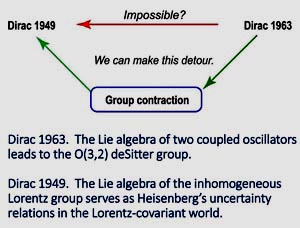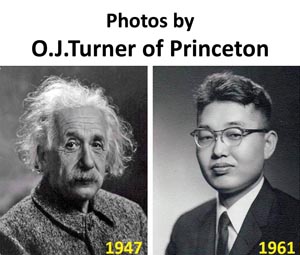-
Click here for Further
Contents of Einstein's E = mc2 .
Heisenberg talks about Einstein.
- Werner Heisenberg was born in 1901 and died in 1976. He was four years old
when Einstein formulated special relativity in 1905. Ten years later, when
he was in high school, Heisenberg became interested in Einstein's theory
and started his physics career out of his respect for Einstein. However,
these two great physicists did not like each other. What went wrong? The
basic point is well known. Einstein never accepted Heisenberg's uncertainty
principle as a fundamental physical law.
It would be interesting to see what Heisenberg says about Einstein in his book entitled Encounters with Einstein. This book has a chapter entitled "Encounters and Conversations with Albert Einstein" covering 17 pages. It would be very nice if you could read this chapter from this webpage, but I was not able to get permission to put it on my website from Princeton University Press who published the latest edition of this book. They said their policy is not to allow any of the contents of their books to be placed on internet pages.
This book has an interesting history. It was copyrighted by Werner Heisenberg in 1983, presumably by the Heisenberg estate. It was originally published by Seabury Press (San Francisco) in 1983 as "Tradition in Science," and is reprinted by Princeton University Press in the Princeton Science Library Edition by arrangement with Harper and Row in 1989. This book contains nine articles written in English by Heisenberg. While I am not allowed to place on my webpage his article on Einstein, I do have the liberty of writing a review of the article summarizing the contents of what he says there, with my own opinions.

Heisenberg and Wigner.
Click here for a story. - Heisenberg liked mathematics and became interested in special relativity
when he was very young. The mathematics of Lorentz transformations was
easy for him to understand, but the physical concept of simultaneity was
very difficult for him to grasp. I suspect that this was his communication
gap he had with Einstein, as I will explain later in this article. When
he was in college in Munich, he learned about Einstein and his theories
from Arnold Sommerfeld who was a great teacher to him. Sommerfeld also
recognized Heisenberg's potential and encouraged him to meet Einstein
personally. The first step toward this process was to attend Einstein's
lectures.

Heisenberg with Bohr (1934). Click here for Bohr and Einstein.
- In addition, Heisenberg became quite interested in atomic physics which
was Sommerfeld's main subject. He was interested in the question of why
classical theories fail to explain atomic phenomena, and how the concept
of light quanta, formulated by Einstein, could explain those "anomalies."
As is well known, Heisenberg's concentrated effort to resolve those puzzles
led him to formulate his uncertainty principle in 1927. In the same book
(which contains his article about Einstein), he has chapters entitled
"Development of Concepts in the History of Quantum Mechanics," and "The
Beginnings of Quantum Mechanics in Goettingen." Quite understandably,
they constitute the first and second chapters of his book.
In the summer of 1922, the Society of German Scientists and Physicists had a meeting in Leipzig, and Einstein was scheduled to give a lecture. Sommerfeld encouraged Heisenberg to attend Einstein's talk. When he went there, a young man gave him a red leaflet saying that the theory of relativity is a totally unproved Jewish speculation, and that it had been undeservedly amplified by through Jewish newspapers on behalf Einstein, a fellow-member of their race. Heisenberg noted there that those leaflets were being handed out by the students of Germany's most respected experimental physicist at that time. Heisenberg did not mention his name, but it is not difficult who that most respected experimentalist was. Instead of Einstein, von Laue gave his lecture. Heisenberg's first attempt to meet Einstein failed in this way.
In early 1926, Heisenberg was invited to give a colloquium on his quantum mechanics by the physicists in Berlin. At that time, Berlin was the citadel of physics. The audience included Planck, von Laue, Nernst, and Einstein. Einstein was quite interested in Heisenberg's talk, and invited Heisenberg to come to his house. This was his first meeting with Einstein. However, Einstein was not happy with Heisenberg's interpretation of his new mechanics. Einstein's position was that every theory in fact contains unobservable quantities. The principle of employing only observable quantities simply cannot be consistently carried out.
Schrödinger and Heisenberg in 1933. The king of Sweden is in the middle. You should know what the occasion was. - In the spring of 1927, Heisenberg succeeded in formulating his uncertainty
relation, emboldened by the wave mechanics formulated by Erwin Schroedinger
in 1926 where electrons are regarded as waves. In the autumn of 1927,
Heisenberg met Einstein again at the Solvay Congress in Brussels. There
Einstein came up with one counter-example to the uncertainty principle
each morning, but, by the dinner time, Heisenberg together with Bohr and
Pauli were able to prove that Einstein's example was consistent with the
uncertainty principle.
Three years later in 1930, Heisenberg met Einstein again at another Solvay Congress in Brussels. There, Bohr did his best to convince Einstein that the uncertainty relations is a fundamental law in physics. Einstein still refused, and they agreed to disagree. It was his last time to see Einstein in Europe. By 1933, the political environment became much worse in Germany, and Einstein moved to the United States. He lived and worked in Princeton where he gave his earlier lecture in 1921.

Einstein's house in Princeton
and his girl friend.
- In 1954, Heisenberg visited
Einstein's house in Princeton. Heisenberg was warned by Einstein's
assistant not to stay with him more than one hour
because of his poor health. Yet, Heisenberg recollects that Einstein was
kind enough to spend almost whole afternoon with him. They talked only
about physics, but Einstein's position on uncertainty relation remained
unchanged. Again, Heisenberg failed to get Einstein's endorsement of his
principle as a fundamental physical law. Einstein died in 1955, and
Heisenberg died in 1976. According to
Johanna Fantova, Einstein was not happy with Heisenberg.
- I would like to encourage you to read Heisenberg's article directly from
his book, instead of relying on my comments. Yet, I do have the
following comments.
- Einstein, Podolsky, and Rosen published their paper in 1935.
Heisenberg did not mention this EPR paper in his article.
- Heisenberg pointed out that Einstein once declared himself as a
pacifist. He then said, in view of his support for the development
of nuclear weapons in the United States, Einstein is not an absolute
pacifist, but a pacifist with some adjective. Here, Heisenberg
forgot to mention whether Hitler's Nazi set-up was an absolute
evil or an evil with a different adjective.
- In his article, Heisenberg says the concept of Einstein's simultaneity
was very difficult to digest. That is right, the simultaneity (or
simultaneous measurements) plays a pivotal role in interpreting the
uncertainty relations. Yet, Heisenberg's interpretation of his
uncertainty does not take into account the Lorentz covariance dictated
by special relativity. If Heisenberg had studied this covariance
question in interpreting his uncertainty principle, he could have
drawn more interest from Einstein.
- Gift to Einstein. Heisenberg could have brought this gift to Einstein when he went to Einstein's house in 1954.

Click here for larger image. - Einstein, Podolsky, and Rosen published their paper in 1935.
Heisenberg did not mention this EPR paper in his article.
- This webage was constructed in 2005. Since then, I made many follow-up pages.
- Einstein and Heisenberg in 1954.
- Einstein and Planck. Bird's eyes and frog's eyes.
- Einstein and Bohr. Did they ever talk about moving
electron orbits of a hydrogen atom?
- Dirac's poems and Feynman's drums.
- Dirac and Heisenberg on Einstein.
- Einstein-Heisenberg Gap: Space-time Entanglement.
- Dirac, Wigner, Feynman in the box of Einstein.
- Einstein and Heisenberg in 1954.

|
- In 2019, I published the following papers telling that Einstein's E = mc2
can be derived from the Heisenberg brackets.
- Einstein's E = mc2 derivable from Heisenberg's Uncertainty Relations,
with Sibel Baskal and Marilyn Noz,
Quantum Reports [1] (2), 236 - 251 (2019),
doi:10.3390/quantum1020021.
ArXiv. For pdf with sharper images, click here. - Role of Quantum Optics in Synthesizing Quantum Mechanics and Relativity,
Invited paper presented at the 26th International Conference on Quantum Optics and Quantum Information (Minsk, Belarus, May 2019).
ArXiv. For pdf with sharper images, click here. - Poincaré Symmetry from Heisenberg's Uncertainty Relations,
with S. Baskal and M. E. Noz,
Symmetry [11](3), 236 - 267 (2019),
doi:10.3390/sym11030409.
ArXiv.

Click here for larger image.
- Einstein's E = mc2 derivable from Heisenberg's Uncertainty Relations,
- copyright@2005 by Y. S. Kim, unless otherwise specified. The photos of
Einstein and Bohr are from the AIP E. Segre Visual Archives.
- Click here for his home page.
- Einstein page.
- Princeton page.
- Stories.
- Click here for his home page.
|
